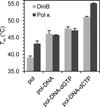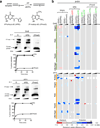Noncognate DNA damage prevents the formation of the active conformation of the Y-family DNA polymerases DinB and DNA polymerase κ
- PMID: 25899385
- PMCID: PMC4504746
- DOI: 10.1111/febs.13304
Noncognate DNA damage prevents the formation of the active conformation of the Y-family DNA polymerases DinB and DNA polymerase κ
Abstract
Y-family DNA polymerases are specialized to copy damaged DNA, and are associated with increased mutagenesis, owing to their low fidelity. It is believed that the mechanism of nucleotide selection by Y-family DNA polymerases involves conformational changes preceding nucleotidyl transfer, but there is limited experimental evidence for such structural changes. In particular, nucleotide-induced conformational changes in bacterial or eukaryotic Y-family DNA polymerases have, to date, not been extensively characterized. Using hydrogen-deuterium exchange mass spectrometry, we demonstrate here that the Escherichia coli Y-family DNA polymerase DinB and its human ortholog DNA polymerase κ undergo a conserved nucleotide-induced conformational change in the presence of undamaged DNA and the correct incoming nucleotide. Notably, this holds true for damaged DNA containing N(2) -furfuryl-deoxyguanosine, which is efficiently copied by these two polymerases, but not for damaged DNA containing the major groove modification O(6) -methyl-deoxyguanosine, which is a poor substrate. Our observations suggest that DinB and DNA polymerase κ utilize a common mechanism for nucleotide selection involving a conserved prechemical conformational transition promoted by the correct nucleotide and only preferred DNA substrates.
Keywords: DNA replication; conformational change; hydrogen exchange mass spectrometry; nucleotide selection; substrate specificity.
© 2015 FEBS.
Conflict of interest statement
J.R.E. is a paid consultant of the Waters Corporation.
Figures






Similar articles
-
Human Y-Family DNA Polymerase κ Is More Tolerant to Changes in Its Active Site Loop than Its Ortholog Escherichia coli DinB.Chem Res Toxicol. 2017 Nov 20;30(11):2002-2012. doi: 10.1021/acs.chemrestox.7b00175. Epub 2017 Sep 6. Chem Res Toxicol. 2017. PMID: 28823149
-
Steric gate residues of Y-family DNA polymerases DinB and pol kappa are crucial for dNTP-induced conformational change.DNA Repair (Amst). 2015 May;29:65-73. doi: 10.1016/j.dnarep.2015.01.012. Epub 2015 Feb 4. DNA Repair (Amst). 2015. PMID: 25684709 Free PMC article.
-
A single amino acid governs enhanced activity of DinB DNA polymerases on damaged templates.Nature. 2006 Jan 12;439(7073):225-8. doi: 10.1038/nature04318. Nature. 2006. PMID: 16407906
-
Escherichia coli Y family DNA polymerases.Front Biosci (Landmark Ed). 2011 Jun 1;16(8):3164-82. doi: 10.2741/3904. Front Biosci (Landmark Ed). 2011. PMID: 21622227 Review.
-
Recent insight into the kinetic mechanisms and conformational dynamics of Y-Family DNA polymerases.Biochemistry. 2014 May 6;53(17):2804-14. doi: 10.1021/bi5000405. Epub 2014 Apr 23. Biochemistry. 2014. PMID: 24716482 Free PMC article. Review.
Cited by
-
Bypass of Abasic Site-Peptide Cross-Links by Human Repair and Translesion DNA Polymerases.Int J Mol Sci. 2023 Jun 29;24(13):10877. doi: 10.3390/ijms241310877. Int J Mol Sci. 2023. PMID: 37446048 Free PMC article.
-
Catalytic mechanism and allosteric regulation of an oligomeric (p)ppGpp synthetase by an alarmone.Proc Natl Acad Sci U S A. 2015 Oct 27;112(43):13348-53. doi: 10.1073/pnas.1505271112. Epub 2015 Oct 12. Proc Natl Acad Sci U S A. 2015. PMID: 26460002 Free PMC article.
-
Biochemical Activity of 17 Cancer-Associated Variants of DNA Polymerase Kappa Predicted by Electrostatic Properties.Chem Res Toxicol. 2023 Nov 20;36(11):1789-1803. doi: 10.1021/acs.chemrestox.3c00233. Epub 2023 Oct 26. Chem Res Toxicol. 2023. PMID: 37883788 Free PMC article.
-
Association Between Single Nucleotide Polymorphisms in DNA Polymerase Kappa Gene and Breast Cancer Risk in Chinese Han Population: A STROBE-Compliant Observational Study.Medicine (Baltimore). 2016 Jan;95(2):e2466. doi: 10.1097/MD.0000000000002466. Medicine (Baltimore). 2016. PMID: 26765445 Free PMC article.
-
Advances in Hydrogen/Deuterium Exchange Mass Spectrometry and the Pursuit of Challenging Biological Systems.Chem Rev. 2022 Apr 27;122(8):7562-7623. doi: 10.1021/acs.chemrev.1c00279. Epub 2021 Sep 7. Chem Rev. 2022. PMID: 34493042 Free PMC article. Review.
References
-
- Echols H, Goodman MF. Fidelity mechanisms in DNA replication. Annu Rev Biochem. 1991;60:477–511. - PubMed
-
- Joyce CM, Benkovic SJ. DNA polymerase fidelity: kinetics, structure, and checkpoints. Biochemistry. 2004;43:14317–14324. - PubMed
-
- Jarosz DF, Godoy VG, DeLaney JC, Essigmann JM, Walker GC. A single amino acid governs enhanced activity of DinB DNA polymerases on damaged templates. Nature. 2006;439:225–228. - PubMed
Publication types
MeSH terms
Substances
Grants and funding
LinkOut - more resources
Full Text Sources
Other Literature Sources
Molecular Biology Databases

